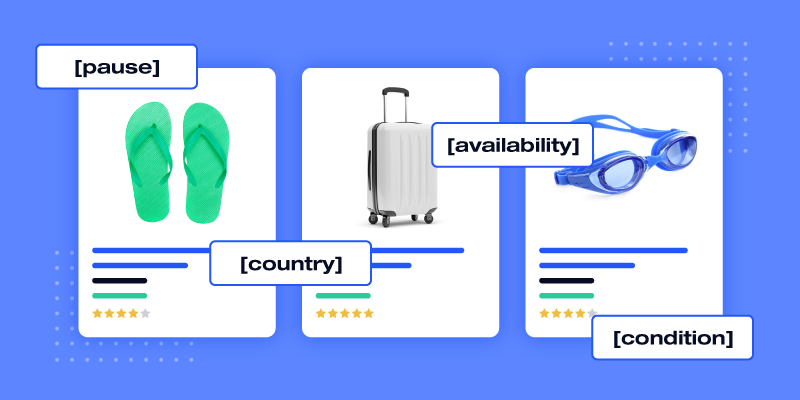Google has been busy adding new attributes to Google Merchant Center feed specifications, and we’re here to help you keep up. We covered Google’s short title attribute and more in a past blog, and the search giant recently released more information about new attribute updates, including pause, country sub-attributes, availability, and condition. Keep reading to learn more about these changes and how to take advantage.
The new [pause] attribute
In April 2022, Google added the pause attribute to Merchant Center, which gives you the ability to pause and restart your ads on a product feed level. This attribute lets you temporarily stop your products from appearing in Shopping ads, Display ads, or local inventory ads for 14 days.
The pause attribute vs. the availability attribute
Before this update, merchants often used the availability attribute to remove products from their ads temporarily. They could set the availability value to out of stock for products they wanted to stop advertising. This practice made it unclear to Google if a merchant wanted to pause ad spend, or if the product was actually out of stock.

Merchants should instead use the pause attribute if they wish to temporarily pause ad spend on a product. Starting in 2023, if your Google Merchant Center data feed is found with the incorrect value in the availability attribute, you risk product ad disapprovals in Google Merchant Center.
How to use the pause attribute
The only supported value for the pause attribute is “ads,” which tells Google to pause your ads for a product, but does not include programs like Buy On Google listings or free listings. If your feed does not contain the ads value under the pause attribute, Google assumes your product is not paused.
The pause attribute pauses a product ad for up to 14 days. If you are looking to pause your ad for a longer period of time, you should use the excluded destination attribute. This attribute allows you to select the programs you want to exclude your product from. For example, to remove a product from showing up in Google’s free organic listings, use “Free_listings” as the value for your excluded destination attribute.
Required: Shipping [country] sub-attribute
To provide customers with accurate shipping rates, Google now requires the country sub-attribute to be added to your feed if you are using the shipping attribute. Products that don’t have a sub-attribute will trigger product feed errors in your Merchant Center Dashboard.
To ensure you do not face future item disapprovals, we recommend that you update your product feed as soon as possible to comply with this new requirement.
The new [availability_date] attribute
Beginning on June 26, 2022, when you use the availability attribute with a “preorder” or “backorder” value, you will have to specify when the item is available for delivery.
How to use the availability date attribute
Your availability date value can be up to one year in the future. For example, if you have a product that isn’t going to be available until May 16, 2023, you can set your product availability value to “backorder,” your availability date to “2023-06-16T13:00-0800” (using the standard formatting guidelines), and indicate the availability date on your landing page as “May 2023” or “May 16, 2023.”
If you do not include the availability date on your product’s landing page and in your product feed, you risk product disapprovals.
Automatic updates to the [condition] attribute
For product description accuracy, Google has included “condition” as an attribute available for automatic updating. Automatic item updates allow Google to update your listings with information found on your product landing pages. Before the update, this feature was only offered to update price and availability attributes. The inclusion of condition gives customers access to more accurate product information.
Opting in or out of automatic item updates
On June 26, 2022, Google will automatically opt your account into automatic item updates for product condition. You can opt out of automatic item updates within the Merchant Center settings. However, if you do decide to opt out, you risk product disapprovals if the product conditions on your landing pages don’t match your product feed.
Unlock your Google Shopping potential with Feedonomics
To prevent frequent item disapprovals and feed errors, it’s important to ensure your product feeds always meet Google’s requirements. But keeping tabs on Google’s latest updates takes time and resources you might not have. Our experts stay up-to-date on Google’s evolving standards and best practices so you don’t have to. Learn more about the full-service feed management experience at Feedonomics.

With its leading data feed management platform, Feedonomics helps brands, retailers, and agencies optimize and list products on hundreds of shopping destinations around the world. Learn more about our full-service solutions for advertising channels and marketplaces.




